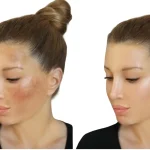Here I will give you detailed information about Fever Blister On Lips. Cold sores and Canker sore to help you deal with these worries and get rid of them.
If you are asking what a fever blister is, the answer is simple, it is a symptom of a virus that infects the mouth area( It is also known as cold sores). The virus attacks the cells and as a side effect it creates an area of inflamed sore skin, which we call a fever blister or cold sore.
A fever blister, also known as a cold sore or herpes labialis, is a small, painful blister that usually appears on the lips or around the mouth. It is caused by the herpes simplex virus (HSV), namely HSV-1.
Fever blisters are very common and can occur at any time in their lives. They are usually harmless and clear up on their own within a week or two. Fever blisters may appear on the skin.
Fever Blisters: Are They Serious?
- In most cases, no. They are usually harmless and clear up on their own within 7-10 days.
- Fever blister complications are uncommon symptoms. Most people who are infected with the HSV-1 virus will experience outbreaks of blisters from time to time, but many have no symptoms.
- However, they can be uncomfortable, causing tingling, itching, burning and pain.
- In rare cases, they can cause complications such as eye infections, especially if you touch the blisters and then touch your eyes. It can also cause you to go blind.
- If you have a weakened immune system, such as a child or an adult with a weakened immune system, the virus can spread to other parts of the body, although this is uncommon.
Symptoms Of Fever Blisters
- Itching, itching or burning around the mouth.
- Red, swollen and painful bumps that turn into fluid-filled blisters.
- Blisters that break, are raised and painful.
- The scabs fall off and reveal pink, healing skin.
- Fever, in some cases.
Causes Of Fever Blisters
This is the most common cause of fever blisters.
The virus that causes genital herpes can also cause cold sores, but this is less common.
Stress can weaken the immune system and trigger outbreaks of fever blisters.
Fever can also cause outbreaks.
Sunburn can damage the skin and make it more susceptible to infection.
Trauma to the lips or face can also trigger an outbreak.
Stages Of A Fever Blister
This is tingling, itching, or burning that occurs a day or two before the blisters appear.
This is the stage when blisters form. They are usually small, red and filled with fluid.
Blisters burst and superficial ulcers form. This is the most painful stage.
Ulcers become scabs and begin to heal.
The scab falls off and the skin heals completely.
Treatment Option
There is no cure or vaccine for herpes simplex virus, but there are effective fever blister treatments. Some treatments are described below.
Over-the-counter antiviral creams: Creams containing docosanol (Abreva) and penciclovir (Denavir) can help decrease the length of the outbreak and relieve discomfort. They function by preventing the virus from replicating.
Prescription antiviral medicine: If you have severe or frequent outbreaks, your doctor may prescribe oral antiviral medications such as acyclovir (Zovirax), famciclovir (Famvir), or valacyclovir. These drugs work best when administered within 48 hours of the initial symptoms.
Pain relievers: Over-the-counter pain medications, such as acetaminophen or ibuprofen, can help alleviate the discomfort caused by fever blisters.
Home remedies: While not a cure, some home remedies can help ease the symptoms:
- Applying cold compresses to the affected area.
- Using lip balms or ointments to keep the area moisturised.
- Avoiding touching or picking at the blisters.
- Managing stress, which can trigger outbreaks.
Can Anyone Avoid A Fever Blister?
Once you’re infected, the HSV-1 virus never leaves your body. It lies dormant in the nerve cells of your skin until a trigger — such as a cold or flu, too much sun, cold weather or stress — causes the virus to replicate uncontrollably, causing cold sores or fever blisters on your lips.
You can avoid catching it by always drinking plenty of water, getting plenty of rest. You can also try to protect yourself against outbreaks by getting your annual flu vaccine and by managing cold sore triggers like stress, fatigue, cold or too much sunlight.
Fever Blister vs. Cold Sore vs. Canker Sore
Fever blisters (also known as cold sores) are painful, fluid-filled sores that develop on the exterior of the mouth, near the lips. Fever blisters are highly infectious.
Canker sores are painful white or yellow sores that exclusively appear within the mouth, typically on the insides of the cheeks, lips, or tongue.
I have given a table below so that everyone can easily understand about the diseases. Hope you can understand about the disease by looking at the table.
| Feature | Fever Blister/Cold Sore | Canker Sore |
|---|---|---|
| Cause | Herpes simplex virus (HSV-1 or HSV-2) | Not fully understood, but likely involves stress, fatigue, dietary deficiencies, and genetics |
| Location | Typically on or around lips, but can also appear on gums, nose or chin | Inside the mouth, on tongue, cheeks, lips or gum |
| Appearance | Clusters of small, fluid-filled blisters with red bases | Single or multiple round or oval sores with white or yellow centre and red border |
| Pain | Yes, often tingling, burning, or itching before blisters appear | Yes, sharp or burning pain |
| Contagiousness | Yes, highly contagious through skin-to-skin contact | No, not contagious |
| Recurrence | Can recur throughout life, often triggered by stress, illness or sun exposure | Can recur, but typically less often than fever blisters |
| Treatment | Antiviral creams, pain relievers, cold compresses | Over-the-counter pain relievers, topical oral rinses, good oral hygiene |
| Healing time | Usually heals within 7-10 days | Usually heals within 1-2 weeks |
Overall
It is important to note that, although there is no cure for herpes simplex virus, many people with the disease lead normal lives and only have periodic outbreaks. If you think you have fever blisters or suffer from recurring outbreaks, you should see a doctor for proper diagnosis and treatment.





